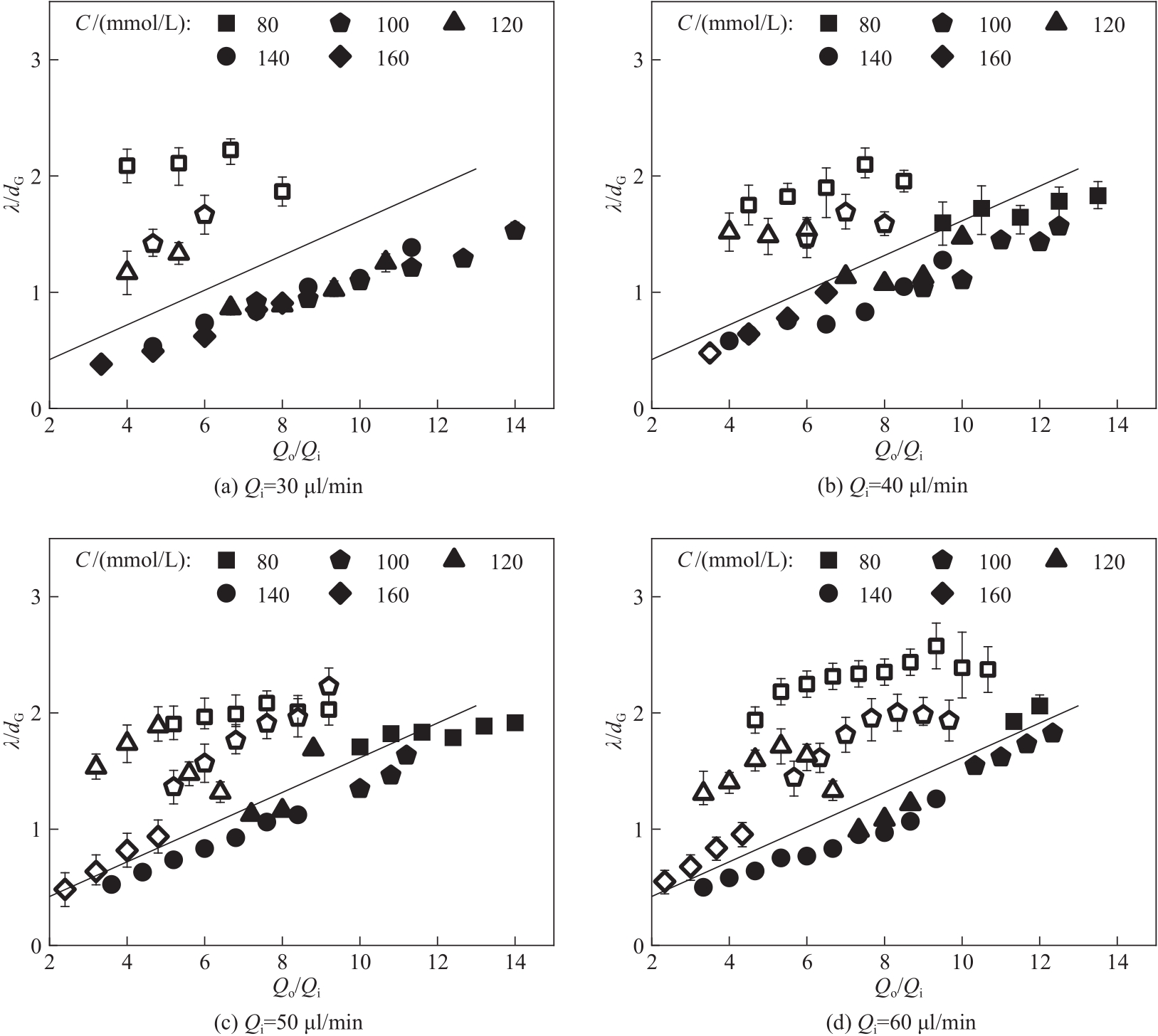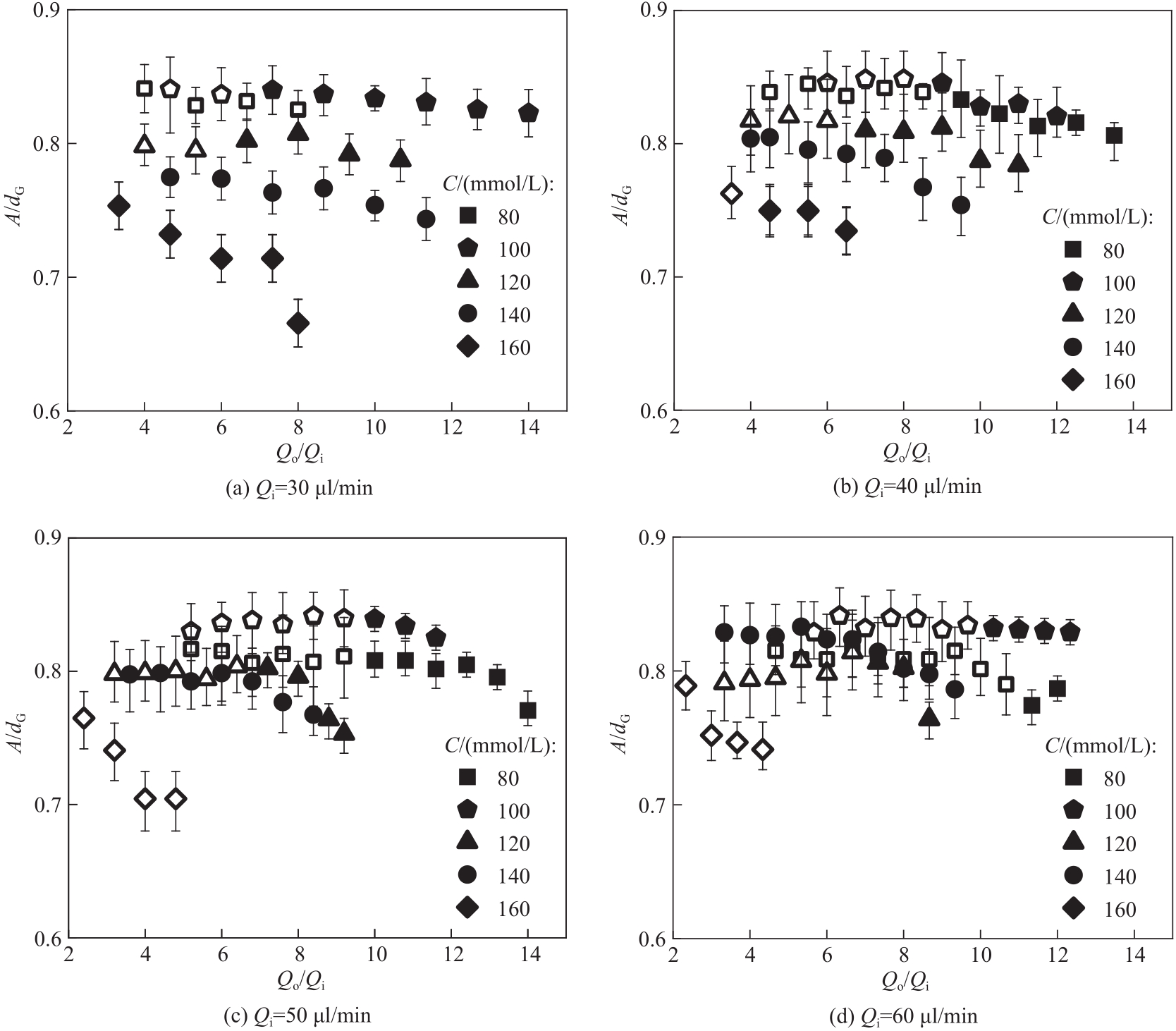CIESC Journal ›› 2022, Vol. 73 ›› Issue (11): 5158-5166.DOI: 10.11949/0438-1157.20220900
• Material science and engineering, nanotechnology • Previous Articles Next Articles
Zhihao WANG1( ), Xin SONG1, Yaran YIN1,2(
), Xin SONG1, Yaran YIN1,2( ), Xianming ZHANG1,2
), Xianming ZHANG1,2
Received:2022-06-27
Revised:2022-09-15
Online:2022-12-06
Published:2022-11-05
Contact:
Yaran YIN
通讯作者:
殷亚然
作者简介:王之豪(1996—),男,硕士研究生,wzh852@126.com
基金资助:CLC Number:
Zhihao WANG, Xin SONG, Yaran YIN, Xianming ZHANG. Regulation of gelation rate on the morphology of helical fibers during microfluidic spinning[J]. CIESC Journal, 2022, 73(11): 5158-5166.
王之豪, 宋欣, 殷亚然, 张先明. 微流控纺丝中凝胶速率对螺旋纤维形貌的调控机制[J]. 化工学报, 2022, 73(11): 5158-5166.
Add to citation manager EndNote|Ris|BibTeX

Fig.6 Effect of sodium citrate concentration on the diameter of helical fibers (hollow icons represent thick helical fibers, solid icons represent thin helical fibers)

Fig.7 Effect of sodium citrate concentration on the initial deformation distance(hollow icons represent thick helical fibers, solid icons represent thin helical fibers)

Fig.8 Effect of sodium citrate concentration on the pitch of helical fibers(hollow icons represent thick helical fibers, solid icons represent thin helical fibers)

Fig.9 Effect of sodium citrate concentration on the amplitude of helical fibers(hollow icons represent thick helical fibers, solid icons represent thin helical fibers)
| 1 | Grolman J M, Zhang D, Smith A M, et al. Rapid 3D extrusion of synthetic tumor microenvironments[J]. Advanced Materials, 2015, 27(37): 5512-5517. |
| 2 | Haines C S, Li N, Spinks G M, et al. New twist on artificial muscles[J]. Proceedings of the National Academy of Sciences, 2016, 113(42): 11709-11716. |
| 3 | Tang M J, Wang W, Li Z L, et al. Controllable microfluidic fabrication of magnetic hybrid microswimmers with hollow helical structures[J]. Industrial & Engineering Chemistry Research, 2018, 57(29): 9430-9438. |
| 4 | Yu Y R, Shang L R, Gao W, et al. Microfluidic lithography of bioinspired helical micromotors[J]. Angewandte Chemie-International Edition, 2017, 56(40): 12127-12131. |
| 5 | Xin C, Yang L, Li J W, et al. Conical hollow microhelices with superior swimming capabilities for targeted cargo delivery[J]. Advanced Materials, 2019, 31(25): 1808226. |
| 6 | Mhanna R, Qiu F M, Zhang L, et al. Artificial bacterial flagella for remote-controlled targeted single-cell drug delivery[J]. Small, 2014, 10(10): 1953-1957. |
| 7 | Ma W J, Ling S D, Zhang J W, et al. Microfluidic fabrication of calcium alginate helical microfibers for highly stretchable wound dressing[J]. Journal of Polymer Science, 2022, 60(11): 1741-1749. |
| 8 | Zhao Y Y, Miao X R, Lin J Y, et al. Coiled plant tendril bioinspired fabrication of helical porous microfibers for crude oil cleanup[J]. Global Challenges, 2017, 1(3): 1600021. |
| 9 | Wang J S, Yuan L, Wang L X, et al. Numerical study on helical fiber fragmentation in chiral biological materials[J]. Transactions of Tianjin University, 2018, 24(1): 51-58. |
| 10 | Gao Y, Li B, Wang J S, et al. Fracture toughness analysis of helical fiber-reinforced biocomposites[J]. Journal of the Mechanics and Physics of Solids, 2021, 146: 104206. |
| 11 | Yang W M, Zhu T K, Jin Y A, et al. Facile fabrication of helical microfluidic channel based on rope coiling effect[J]. Microsystem Technologies, 2017, 23(7): 2957-2964. |
| 12 | Cai Q W, Ju X J, Zhang S Y, et al. Controllable fabrication of functional microhelices with droplet microfluidics[J]. ACS Applied Materials & Interfaces, 2019, 11(49): 46241-46250. |
| 13 | Dong Y, Wang L, Wang J, et al. Graphene-based helical micromotors constructed by "microscale liquid rope-coil effect" with microfluidics[J]. ACS Nano, 2020, 14(12): 16600-16613. |
| 14 | Du X Y, Li Q, Wu G, et al. Multifunctional micro/nanoscale fibers based on microfluidic spinning technology[J]. Advanced Materials, 2019, 31(52): 1903733. |
| 15 | 马文峻, 陈卓, 凌斯达, 等. 3D打印微流控通道快速可控制备核壳微纤维[J]. 化工学报, 2022, 73(1): 434-440. |
| Ma W J, Chen Z, Ling S D, et al. Fast and controllable preparation of core-shell microfibers by 3D printing microfluidic device[J]. CIESC Journal, 2022, 73(1): 434-440. | |
| 16 | 崔婷婷, 刘吉东, 解安全, 等. 多功能纳米纤维微流体纺丝技术及其应用研究进展[J]. 纺织学报, 2018, 39(12): 158-165. |
| Cui T T, Liu J D, Xie A Q, et al. Microfluidic spinning technology for multifunctional nanofibers and application and research progress thereof[J]. Journal of Textile Research, 2018, 39(12): 158-165. | |
| 17 | 杨慧丽. 微流控制备聚合物螺旋、超螺旋微纤维及螺旋管研究[D]. 苏州: 苏州大学, 2019. |
| Yang H L. Studies on the preparation of polymeric helical, superhelical microfibers and helical tubes via microfludic spinning[D]. Suzhou: Soochow University, 2019. | |
| 18 | 梁哲. 基于微流控技术的生物水凝胶纤维的制备及应用[D]. 北京: 清华大学, 2018. |
| Liang Z. Microfluidic fabrication of bioinspired hydrogel microfibers[D]. Beijing: Tsinghua University, 2018. | |
| 19 | Yu Y R, Fu F F, Shang L R, et al. Bioinspired helical microfibers from microfluidics[J]. Advanced Materials, 2017, 29(18): 1605765. |
| 20 | 雷明月, 颜超, 崔莉, 等. 海藻酸钙纤维非织造布的水凝胶化改性及机理[J]. 化工学报, 2018, 69(4): 1765-1773. |
| Lei M Y, Yan C, Cui L, et al. Gelatinization modification of calcium alginate fibers nonwoven fabrics and mechanism research[J]. CIESC Journal, 2018, 69(4): 1765-1773. | |
| 21 | 郭永诗. 微流控纺丝技术制备非典型螺旋微纤维及其应用[D]. 江门: 五邑大学, 2021. |
| Guo Y S. Microfluidic spinning technology-based fabrication of microfibers with atypical helical structure for applications[D]. Jiangmen: Wuyi University, 2021. | |
| 22 | 谭昕玥, 巨晓洁, 谢锐, 等. 具有油相隔离层的微流控法可控制备中空微纤维[J]. 高分子材料科学与工程, 2022, 38(3): 1-9+17. |
| Tan X Y, Ju X J, Xie R, et al. Controllable preparation of hollow microfibers bymicrofluidic with oil phase as isolatoin layer[J]. Polymer Materials Science And Engineering, 2022, 38(3): 1-9+17. | |
| 23 | Meng Z J, Wang W, Xie R, et al. Microfluidic generation of hollow Ca-alginate microfibers[J]. Lab on a Chip, 2016, 16(14): 2673-2681. |
| 24 | Blandino A, Macías M, Cantero D. Formation of calcium alginate gel capsules: influence of sodium alginate and CaCl2 concentration on gelation kinetics[J]. Journal of Bioscience and Bioengineering, 1999, 88(6): 686-689. |
| 25 | Qin Y M. Gel swelling properties of alginate fibers[J]. Journal of Applied Polymer Science, 2004, 91(3): 1641-1645. |
| 26 | Tottori S, Takeuchi S. Formation of liquid rope coils in a coaxial microfluidic device[J]. RSC Advances, 2015, 5(42): 33691-33695. |
| 27 | 杨亚楠, 李峻峰, 王立, 等. 柠檬酸钙:一种有趣的有机钙生物医用材料[J]. 中国组织工程研究, 2021, 25(10): 1609-1615. |
| Yang Y N, Li J F, Wang L, et al. Calcium citrate: an interesting organic calcium biomedical material[J]. Chinese Journal of Tissue Engineering Research, 2021, 25(10): 1609-1615. | |
| 28 | Nie M, Takeuchi S. Microfluidics based synthesis of coiled hydrogel microfibers with flexible shape and dimension control[J]. Sensors and Actuators B-Chemical, 2017, 246: 358-362. |
| 29 | Liu R, Kong B, Chen Y, et al. Formation of helical alginate microfibers using different G/M ratios of sodium alginate based on microfluidics[J]. Sensors and Actuators B: Chemical, 2020, 304: 127069. |
| 30 | Shao L, Gao Q, Zhao H M, et al. Fiber-based mini tissue with morphology-controllable gelma microfibers[J]. Small, 2018, 14(44): 1802187. |
| 31 | Nunes J K, Constantin H, Stone H A. Microfluidic tailoring of the two-dimensional morphology of crimped microfibers[J]. Soft Matter, 2013, 9(16): 4227-4235. |
| 32 | Ribe N M, Habibi M, Bonn D. Liquid rope coiling[J]. Annual Review of Fluid Mechanics, 2012, 44(1): 249-266. |
| 33 | Yasuda K. Investigation of the analogies between viscometric and linear viscoelastic properties of polystyrene fluids[D]. Cambridge: Massachusetts Institute of Technology, 1979. |
| 34 | Tanner R I. A theory of die-swell[J]. Journal of Polymer Science Part A-2: Polymer Physics, 1970, 8(12): 2067-2078. |
| 35 | Cubaud T, Jose B M, Darvishi S. Folded micro-threads: role of viscosity and interfacial tension[J]. Physics of Fluids, 2011, 23(4): 042002. |
| 36 | Ma W J, Liu D, Ling S D, et al. High-throughput and controllable fabrication of helical microfibers by hydrodynamically focusing flow[J]. ACS Applied Materials & Interfaces, 2021, 13(49): 59392-59399. |
| [1] | Xuanzhi HE, Yongqing HE, Guiye WEN, Feng JIAO. Ferrofluid droplet neck self-similar breakup behavior [J]. CIESC Journal, 2023, 74(7): 2889-2897. |
| [2] | Qin YANG, Chuanjian QIN, Mingzi LI, Wenjing YANG, Weijie ZHAO, Hu LIU. Fabrication and properties of dual shape memory MXene based hydrogels for flexible sensor [J]. CIESC Journal, 2023, 74(6): 2699-2707. |
| [3] | Shiting XIE, Zhuang LIU, Rui XIE, Xiaojie JU, Wei WANG, Dawei PAN, Liangyin CHU. Study on preparation of poly(N-isopropylacrylamide-co-allylthiourea) smart microgels and responsive performance of Hg2+ [J]. CIESC Journal, 2023, 74(6): 2689-2698. |
| [4] | Lei WANG, Lei WANG, Yunlong BAI, Liuliu HE. Preparation of SA lithium ion sieve membrane and its adsorptive properties [J]. CIESC Journal, 2023, 74(5): 2046-2056. |
| [5] | Lu DENG, Xiaojie JU, Wenjie ZHANG, Rui XIE, Wei WANG, Zhuang LIU, Dawei PAN, Liangyin CHU. Controllable preparation of radioactive chitosan embolic microspheres by microfluidic method [J]. CIESC Journal, 2023, 74(4): 1781-1794. |
| [6] | Shaojie ZHENG, Jianbin WANG, Jijiang HU, Bo-Geng LI, Wenbo YUAN, Zong WANG, Zhen YAO. Regulation of structure and mechanical properties of poly(propylene-butene) alloys by monomer composition switching [J]. CIESC Journal, 2023, 74(2): 904-915. |
| [7] | Xintong HUANG, Yuhao GENG, Hengyuan LIU, Zhuo CHEN, Jianhong XU. Research progress on new functional nanoparticles prepared by microfluidic technology [J]. CIESC Journal, 2023, 74(1): 355-364. |
| [8] | Duanhui GAO, Weiqiang XIAO, Feng GAO, Qian XIA, Manqiu WANG, Xinbo LU, Xiaoli ZHAN, Qinghua ZHANG. Preparation and application of polyimide-based aerogels [J]. CIESC Journal, 2022, 73(7): 2757-2773. |
| [9] | Dawei PAN, Wei WANG, Rui XIE, Xiaojie JU, Zhuang LIU, Liangyin CHU. Progress on regulation of meso-scale structures for microfluidic emulsion-template synthesis of functional microparticles [J]. CIESC Journal, 2022, 73(6): 2306-2317. |
| [10] | Yong LU, Duiping LIU, Chenyang LI, Jibin ZHOU, Mao YE. Investigation on MTO catalyst morphology and its coke amount by fiber-optic endoscope image method [J]. CIESC Journal, 2022, 73(6): 2662-2668. |
| [11] | Cuiping TANG, Yanan ZHANG, Deqing LIANG, Xiang LI. Inhibition effect of chain end modified polyvinyl caprolactam on methane hydrate formation [J]. CIESC Journal, 2022, 73(5): 2130-2139. |
| [12] | Xiqiang ZHAO, Jian ZHANG, Shuang SUN, Wenlong WANG, Yanpeng MAO, Jing SUN, Jinglong LIU, Zhanlong SONG. Study on the performance of biochar modified microspheres to remove inorganic phosphorus from chemical wastewater [J]. CIESC Journal, 2022, 73(5): 2158-2173. |
| [13] | Shiyi GE, Yao YANG, Zhengliang HUANG, Jingyuan SUN, Jingdai WANG, Yongrong YANG. Analyzing particle growth and morphology evolution of polyethylene based on electrostatic separation [J]. CIESC Journal, 2022, 73(4): 1585-1596. |
| [14] | Li WAN, Deqing LIANG. Study on a biodegradable kinetics hydrate inhibitor [J]. CIESC Journal, 2022, 73(2): 894-903. |
| [15] | Wenjun MA, Zhuo CHEN, Sida LING, Jingwei ZHANG, Jianhong XU. Fast and controllable preparation of core-shell microfibers by 3D printing microfluidic device [J]. CIESC Journal, 2022, 73(1): 434-440. |
| Viewed | ||||||
|
Full text |
|
|||||
|
Abstract |
|
|||||